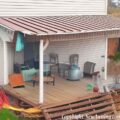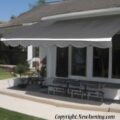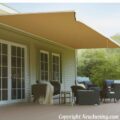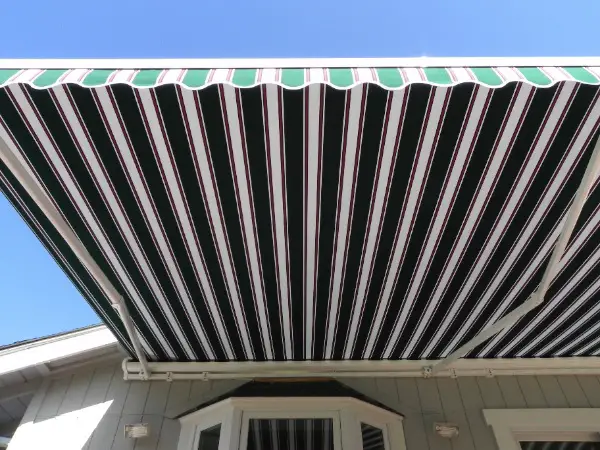Last Updated:September 12, 2025
How to Waterproof an Awning
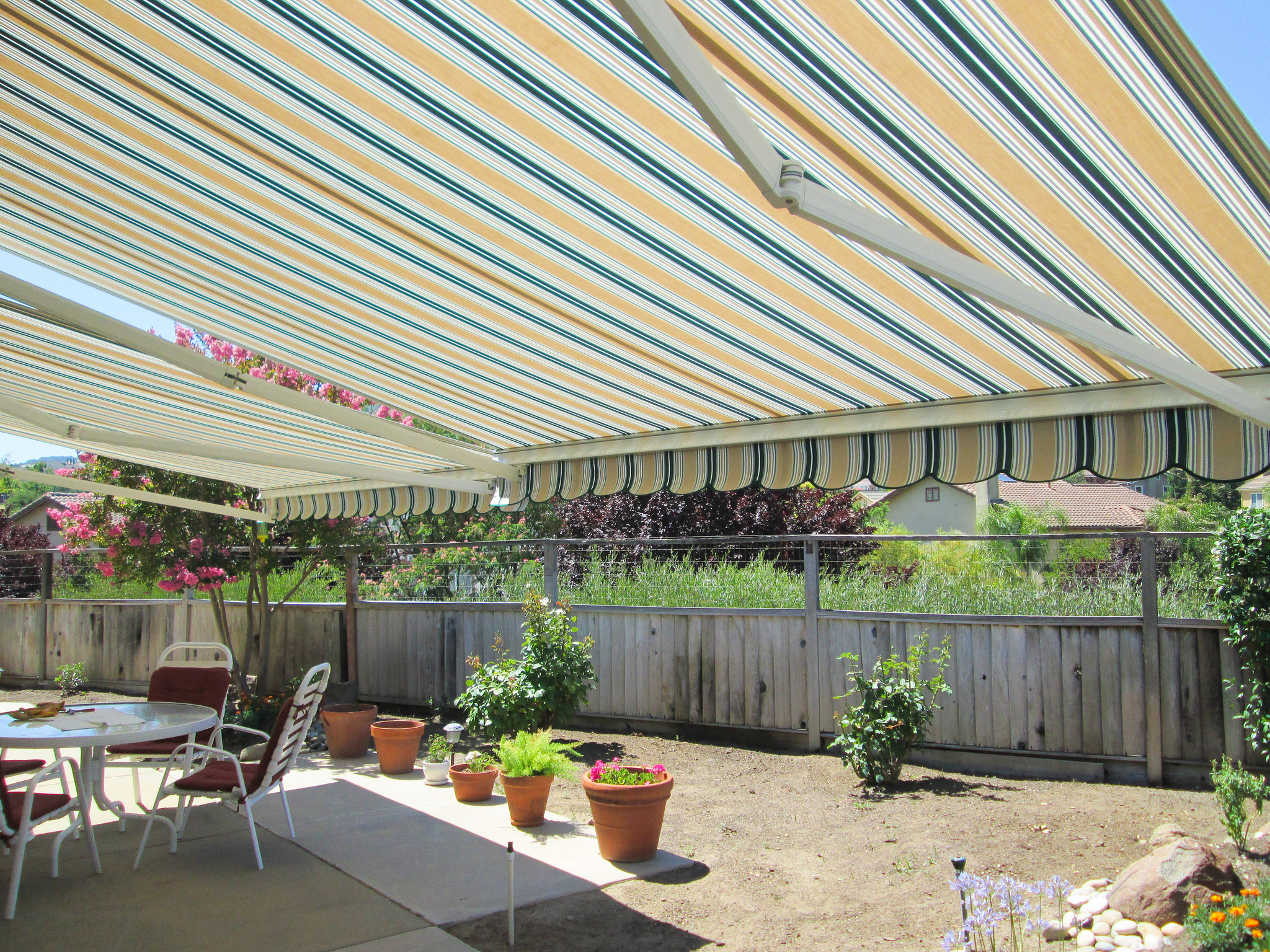
You are sitting on your patio, and it begins to rain. To your surprise, the same fabric that used to completely protect your deck and furniture is now leaking.
Whether it’s seeping through the seems, dripping down the frame, or simply allowing a few drops, a leaky awning is not pleasant. We had this happen to our awning, and we’ll share what worked for us.
We love interacting with our readers so send us a tweet @newawning with pictures or videos of your waterproofing projects.
Why do awnings leak?
Before we dive into fixing the problems, we need to understand the root cause. Most awnings start out waterproof or at least very water resistant. Over time, acrylic and canvas fabric threads will expand and contract as they get damp and dry out. This stretching can create gaps that allow the rainwater to drip through.
Vynil awnings have a different primary issue in leaking around seams. They aren’t woven in the same method as acrylic and canvas awnings so they have less issue with stretching.
Another major cause of water leakage is that the wind can pull the fabric from the frame. This is true for all materials, and it can cause the water to roll of the shade differently than the manufacturer intended.
Clean the awning
We’ve written a detailed guide to clean your awning, but if you’d like the highlights to remove any debris, and then wipe it down with a soft bristle brush. If it just rained, you can skip the need to hose down the awning.
The reason you want to start with the cleanest possible surface is that the waterproofing liquid will create a barrier around the fabric. Anything left under it will become incredibly challenging to clean.
Choosing the waterproof solution
In our research, there is some major difference at the very low-end of the spectrum, but we had success with the middle price brand of 303 Fabric Guard that we didn’t feel the need to splurge for the most expensive product.
For complete disclosure, we live in Arizona so our primary issue is dealing with extreme heat in the summer and the constant risk of the fabric cracking due to the heat.
If you live in Chicago, Boston or Seattle that face a lot of rain or much colder environments, you may have a different experience with us. That being said, we’d love to hear from readers in that area of their recommended products.
Protect your home and furniture
You will want to apply some painters tape or plastic around the edges of the awnings. We also recommend either moving the furniture or using a drop cloth.
Applying the waterproof solution
Our favorite method of applying the waterproofing solution is through a spray bottle on the mist setting. We normally do three coats allowing each one to dry for 4 hours. This makes it a great weekend project as it only takes about 15 minutes to spray a 6’x8′ awning.
The first application is a base coat where you don’t need to worry about being super detail oriented. You’ll want to cover most of the area, but a few small gaps are acceptable.
Once it dries, there should be a slight difference in appearance so you’ll want to make sure that any gaps are covered with the second spraying.
For the third and final pass, you want to take the most time. We tend to overspray on this coat. This will be the last chance you get to complete the barrier to ensure the fabric is totally encased.
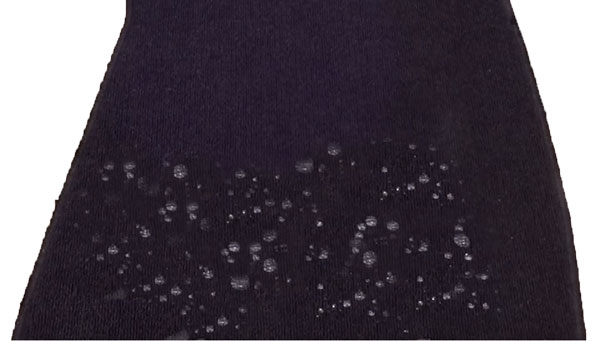
Testing the barrier
Testing the barrier
Once the final coat is fully dry, you can take your garden hose and spray the awning. You’ll want to see the water bead up and roll off the fabric. When it does this you can rest assured that it will also stand up when the rain begins to fall.
Frequently asked questions
We originally wrote this article in 2016, and over the last 2.5 years this has become one of our most popular posts. We’ve seen so many great questions from our readers, and we’ve updated the guide to include them.
- Questions: Does this provide additional UV protection?
No. This product does not affect the UV absorption of the fabric. If you need want to increase this, we suggest you use Star Bright instead.
- Questions: Does this slow fading?
Yes, but the results depend on the specific fabric. For solution dyed acrylic fabrics which are already super resistant to fading the benefits will be present, but marginal. For vinyl and canvas dyed awnings, the impact will be significantly more substantial. The reason is that solution dyed acrylics are the same color throughout the fabric, whereas the other fabrics can have their pigment worn away from the precipitation.
- Questions: Will this make the awning flame retardant?
No, it will not.
- Question: Will this help with mold or mildew on the awning?
Absolutely! Both mold and mildew grow when moisture penetrate the fabric which creates a breeding ground for the mold and mildew. The repellent will create a barrier that stops the water from getting to the material. You will want to remove any mold and mildew from your awning before applying this.
- Question: How can I tell that it’s working?
The water will bead up and run off. As the image at the top of this post illustrates, the water droplets are easily visible so there should not be any question whether or not this is working.
- Question: How long does the protection last?
This depends on many factors including how much rain you have and whether or not your awning is exposed to the elements year around. For retractable awnings that are taken down in the winter, a single application can last for years. If the awning is out year round, some people have reported that they apply it twice per year. The easiest way is to spray a small amount of water and watch whether it beads up and rolls off or begins to absorb into the fabric.
- Question: Does this work for colder climates?
Since writing this in 2016, we’ve heard from many customers that 303 Fabric Guard worked in their area. Thus far, we’ve yet to have anyone contact us that it failed them.
- Question: How do you address leaks between the wall of the home and the awning?
Depending where you live, there is either spray foam or silicone that can fill small gaps like this. Instead of making a blanket suggestion for all areas, we’d recommend a trip to your local home depot. They’ll be able to advise you on the best sealant for your area since this is a common problem.
- Question: Does this work for metal awnings?
Nope. This only works for fabric awnings that are either acrylic, polyester, vinyl or canvas. We don’t feel comfortable giving any advice on waterproofing metal awnings since we haven’t tested any products.
- Question: Does painting an awning make it waterproof
In most cases, applying a new coat of paint to your fabric awning will not improve its ability to repel water. We do have a complete guide to painting you awning fabric that includes steps about waterproofing if you need to solve both issues.
Conclusion
Thanks for making to to the end of our waterproofing guide. We’ve put in a lot of work to make the best resource possible. But as a disclaimer, we’re just regular homeowners who share our opinions.
If you have found a product that works better, we’d love to hear from you. We’re not interested in product pitches from vendors.
Also, send us a tweet if you have ideas for another article OR have some questions on this post. We’ll happily answer it if we can, and we will then include it in our FAQ section above.



